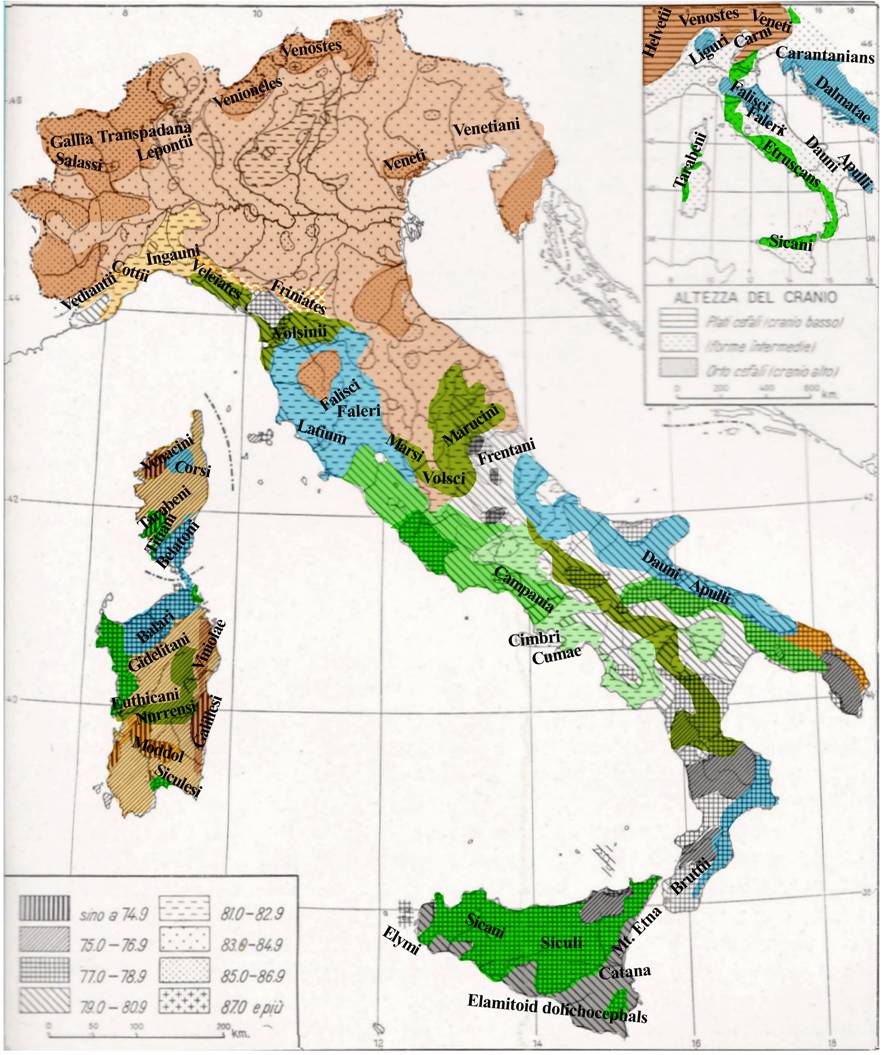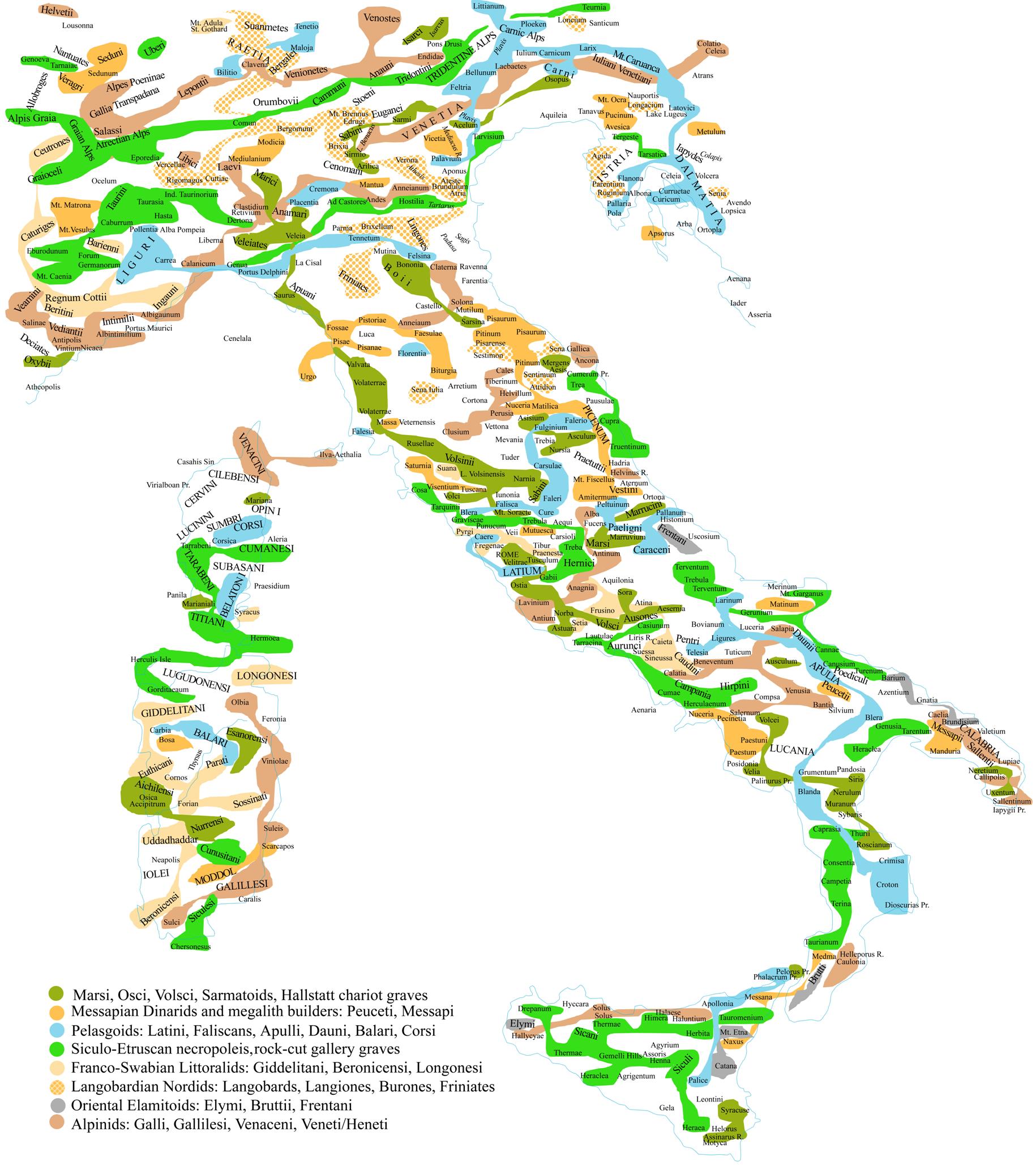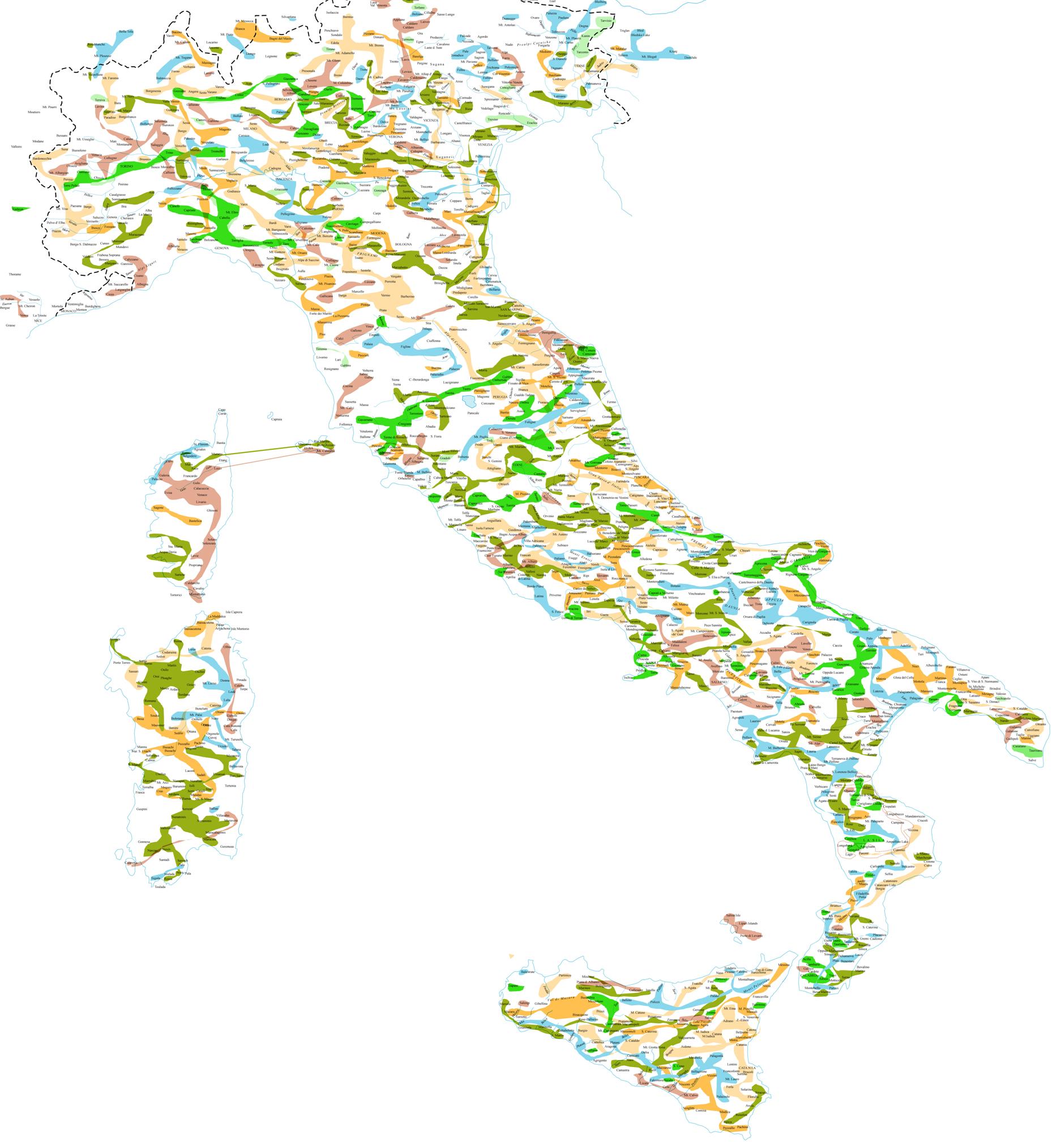|
|

Map 42. A racial overlay of Biasuttis
map of Italian cephalic indices
(from P. Bělíček: The
Analytic Survey of European Anthropology, Prague 2018, Map 42, p. 138)
|
|
Italic racial varieties have to be anchored in prehistoric evidence
and coordinated with archaeological cultures. Their traces are usually sought
in Neolithic pottery but many conspicuous coincidences appear also in ethnonymy and the toponomastic
studies of places names. In the middle Palaeolithic Italy was occupied by
the Epi-Mousterian culture of Uluzzians
(49,000 BP) and their
descendants may have contributed to the Dinaric
revival in the Chalcolithic Bronze Age. As a part
of megalithism widespread in western Europe its
tendencies affected also neighbouring tribes. Megalithic towers nuraghi were concentrated in the northwest Sardinia, talayots prevailed in Menorca and Majorca, while
chamber-tomb navetas and table-shaped taulas abounded in the Balearic Islands. However, the
Corsican Belatoni developed a side branch of
megalithism called Torrean
civilisation owing to building smaller towers torri.
It was focused on erecting menhirs and standing
stones. It was a sort of Epi-Cardial Pelasgoid megalithism different
from genuine cupola-shaped cairn constructions. The Balearic chamber-tomb navetas were represented by Naveta
des Todons, i.e. boat-shaped chamber-tomb of
Teutons from hewn stones. They may be classified as
a type of Epi-Microlithic megalithism
blending Dinaric cairns with rock-cut
galleries. `
|
Italic family = Hallstatt
Sarmatids È Alpinids È Etruscoids È Epi-Cardial Pelasgids È Poladan lake-
dwellers È Messapian dolmen-builders È Abruzzian Bellbeaker Folk È Bruttian Elamitoids.
|
|
Megalith-builders
in Italy (cults of Uranos and
Saturn): Piceni, Vestini,
Peucetii, Messapii.
Ancestors: Uluzzian culture (south central Italy, 49,000 BP), Artenacian (France, Switzerland, 2400 BC),
the Ozieri culture or San Michele culture (north Sardinia,
3200 BC, pre-nuragic architecture),
Messapian or
Salentinian culture (800 BC), Picenian
or Umbrian culture (500 BC).
Megalith dolmens in Italy: dolmen di Albarosa, Passage Grave in Puglia, dolmen di Frisari in Puglia.
Toponymic
chain NW-SE: Veragri, Seduni,
Pisaec, Pisanaec,
Pisarensec, Urgoc,
Saturniac, Piceni,
Vestini, Peucetii, Messapii.
|
|
Hallstatt Sarmatids
(princely burials, chariot burials, cults of Mars the wood-pecker, ver sacra raids,
elopements of brides) = (Marsi,
Marrucini) + (Sabini/Sabines,
Samnites) + (Oscans/Osci, Ausones),
(Volsci, Vulci, Volsinii) + Boii.
|
|
Epi-Cardial Impresso Ware (Epi-Levalloisian
residues?, Pelasgoid seaside fishermen and
seafarers,
Sea
Peoples, pottery with imprints of the
cockle, a marine mollusc Cardium edulis; waterside
dwellings in
conical roundhouses, menhirs, standing stones,
stone alleys, Y-hg T).
|
|
Italic
Pelasgoids →
Paeligni, Apulli,
Daunii, Pelasgoid
Oenotrians (Apullian roundhouse trullo,
menhirs, standing
stones).
Menhir standing stones in Puglia: Balice, Casamassima, Castelberg, Casermette, Spongano, Bagnolo.
Apullo-Daunian ethnonymic roots = Pal-/Apul-
+ Daun- + Lar- + Kar- + Let-.
Toponymic
chain of ethnonyms N-SE: Carni,
Bellunumc, Palaviumc,
Tennetumc, Felsinac,
Peltuinumc,
Paeligni, Pallanumc,
Caraceni, Larinumc,
Daunii, Apulia/Puglia,
Apulli, Blerac,
Blandac, Dioscuriash,
Crotonc, Pelorush,
Phalacrumc, Apolloniac,
Palicec.
|
|
Epi-Aurignacian lake-dwellers grouped as Poladans (terramare cultures of lake-dwellings, palafitti on
piles over a
lake, acorn-eaters, blood group B, Y-hg C).
Chassey-Lagozza-Cortaillod group: Lagozza culture (North Italy, 3900 BC), Polada culture (Lombardy
2160 BC), Terramare culture (Emilia-Romagna, 1700 BC), Romagna group, Bonnanaro culture
(Sardinia, 1900 BC), Palaffite culture (Pianura Padana).
Poladans → Liguri? + Falisci + Latini.
Toponymic
chain N-SE: Bilitioc, Carreac, Florentiac,
Falesiac, Falerioc,
Fulginiumc, Carsulaec,
Faliscac,
Falisci, Blerac, Caerec, Latium, Latini, Lautulaec.
|
|
Epi-Tardenoisian Etruscoid cultures
(necropoleis, rock shelters, rock-cut gallery
graves, hepatomancy,
burnished ware, blood group B, Y-hg R1b-U152 (S28)).
Etruscoid archaeology: Stentinello culture (Sicily, Calabria, c. 4800
BC), Gaudo culture (Campania
2900 BC), Laterza/Laterza-
Cellino San Marco culture (2900 BC), Remedello culture (cultura
di
Remedello, Northern Italy, cca 2700 BC), Rinaldone culture (cca 2200 BC, Lazio), Canegrate culture
(western Lombardy, 1300 BC), Apennine culture (1500 BC, burnished ware), Ischia and Lipari group.
Etruscoid → Raeti
+ Etrusci + Camerini + Umbrii + Hernici + Napolitani + Campani +
Calabrese +
+ Sikani/Sikanoi + Siceli/Siculi
(Greek Sikeloi,
Egyptian Shekelesh,
necropoleis of Pantaleica
and
Cassibile, tombe a formo oven-shaped and beehive-shaped tombs).
|
|
Italic Alpinids = Gravettians (33,000 BP) + Tardi-Gravettians (9,000 BC), Lusatians
(1170 BC).
Tardi-Gravettian Gallids → Helvetii,
Salassi, Lepontii,
Laevi.
Venuses: Venus of Vicofertile, Venus of Savignano, Venus
of Ventimiglia, Venus of Parabita.
Colchians → before 1184 Anatolids
+ Trojans → after 1184 Lusatian cultures, Lusatian Urnfielders.
Lusatians
(cremation burials, hut-urns, face-urns, short-sized stature, brachycephals; red caps;
satemisation, palatalisation,
melodic accent) → Venionetes, Venostes,
Venetians, Veneti/Heneti,
Venetulani, Albani, populi
Albanenses in Rome.
Lusatian Urnfielders in Italy → Atestine/Este
culture (1000 BC, situlas) + Golasecca
(Lombardy,
900 BC) + Villanovan (Bologna,
1100 BC: double-cone urns, hut urns,
also pit graves,
well
tombs) + Latial culture (Latium,
1000 BC, hut urns in deep shafts).
|
|
Italian Nordids (Gothids) and Caucasoids (Gothonids) = Linear Ware + Bell
Beakers + Caucasoids.
Bellbeaker
Folk in Italy → Ortucchio
culture (2670 BC, Bellbeaker Folk, cultura del bicchiere
campaniforme, province
of Abruzzes.
Bellbeaker Folk in Italy → Friniates + Senones/Sienians
(from Siena/Sena/Saenae) + Praetuttii?
Elamitoid Caucasoids in Sicily
and Calabria (Sicilian multicellular flat-roofed houses, heraldry
with
the bulls head, bull walking, Y-hg J1).
Elamitoid Caucasoids → Italiotes + Bruttii/Βρέττιοι + Elimi/Elymoi + Caudini + Frentani.
|
Table 43. A survey of correlations between
Italic races and their archaeological cultures
Extract from Pavel Bělíček: The Analytic
Survey of European Anthropology, Prague 2018, Map 45, p. 152, pp. 137-144.
|
|



